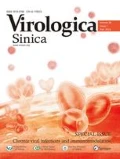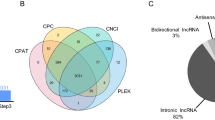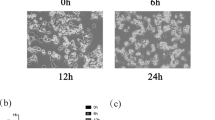Abstract
The roles of lncRNAs in the infection of enteroviruses have been barely demonstrated. In this study, we used coxsackievirus B3 (CVB3), a typical enterovirus, as a model to investigate the expression profiles and functional roles of lncRNAs in enterovirus infection. We profiled lncRNAs and mRNA expression in CVB3-infected HeLa cells by lncRNA-mRNA integrated microarrays. As a result, 700 differentially expressed lncRNAs (431 up-regulated and 269 down-regulated) and 665 differentially expressed mRNAs (299 up-regulated and 366 down-regulated) were identified in CVB3 infection. Then we performed lncRNA-mRNA integrated pathway analysis to identify potential functional impacts of the differentially expressed mRNAs, in which lncRNA-mRNA correlation network was built. According to lncRNA-mRNA correlation, we found that XLOC-001188, an lncRNA down-regulated in CVB3 infection, was negatively correlated with NFAT5 mRNA, an anti-CVB3 gene reported previously. This interaction was supported by qPCR detection following siRNA-mediated knockdown of XLOC-001188, which showed an increase of NFAT5 mRNA and a reduction of CVB3 genomic RNA. In addition, we observed that four most significantly altered lncRNAs, SNHG11, RP11-145F16.2, RP11-1023L17.1 and RP11-1021N1.2 share several common correlated genes critical for CVB3 infection, such as BRE and IRF2BP1. In all, our studies reveal the alteration of lncRNA expression in CVB3 infection and its potential influence on CVB3 replication, providing useful information for future studies of enterovirus infection.







Similar content being viewed by others
Abbreviations
- ARRDC3:
-
Arrestin domain containing 3
- BRE:
-
Brain and reproductive organ-expressed
- CCRN4L:
-
Carbon catabolite repression 4-like
- CDCA3:
-
Cell division cycle associated 3
- CVB3:
-
Coxsackievirus B3
- FIBP:
-
FGF1 intracellular binding protein
- HLA-DQA1:
-
Major histocompatibility complex, class II, DQ alpha 1
- hnRNPH3:
-
Heterogeneous nuclear ribonucleoprotein H3
- IRF2BP1:
-
Insulin-like growth factor 2 mRNA-binding protein 1
- KEGG:
-
Kyoto Encyclopedia of Genes and Genomes
- LncRNA:
-
Long non-coding RNA
- MDA5:
-
Melanoma differentiation associated gene 5
- MTX1:
-
Metaxin 1
- NEMF:
-
Nuclear export mediator factor
- NFAT5:
-
Nuclear factor of activated T cells 5
- SNHG11:
-
Small nucleolar RNA host gene 11
- TIMP1:
-
TIMP metallopeptidase inhibitor 1
- TMED9:
-
Transmembrane p24 trafficking protein 9
- ZNF295:
-
Zinc finger protein 295
References
Amaral PP, Clark MB, Gascoigne DK, Dinger ME, Mattick JS (2011) lncRNAdb: a reference database for long noncoding RNAs. Nucleic Acids Res 39:D146–D151
Anderson DM, Anderson KM, Chang CL, Makarewich CA, Nelson BR, McAnally JR, Kasaragod P, Shelton JM, Liou J, Bassel-Duby R, Olson EN (2015) A micropeptide encoded by a putative long noncoding RNA regulates muscle performance. Cell 160:595–606
Benetatos L, Vartholomatos G, Hatzimichael E (2011) MEG3 imprinted gene contribution in tumorigenesis. Int J Cancer 129:773–779
Birney E, Stamatoyannopoulos JA, Dutta A, Guigo R, Gingeras TR, Margulies EH, Weng Z, Snyder M, Dermitzakis ET, Thurman RE et al (2007) Identification and analysis of functional elements in 1% of the human genome by the ENCODE pilot project. Nature 447:799–816
Cabili MN, Trapnell C, Goff L, Koziol M, Tazon-Vega B, Regev A, Rinn JL (2011) Integrative annotation of human large intergenic noncoding RNAs reveals global properties and specific subclasses. Genes Dev 25:1915–1927
Carninci P, Kasukawa T, Katayama S, Gough J, Frith MC, Maeda N, Oyama R, Ravasi T, Lenhard B, Wells C et al (2005) The transcriptional landscape of the mammalian genome. Science 309:1559–1563
Cheetham SW, Gruhl F, Mattick JS, Dinger ME (2013) Long noncoding RNAs and the genetics of cancer. Br J Cancer 108:2419–2425
Childs KS, Goodbourn S (2003) Identification of novel co-repressor molecules for Interferon Regulatory Factor-2. Nucleic Acids Res 31:3016–3026
Draghici S, Khatri P, Tarca AL, Amin K, Done A, Voichita C, Georgescu C, Romero R (2007) A systems biology approach for pathway level analysis. Genome Res 17:1537–1545
Ebert MS, Neilson JR, Sharp PA (2007) MicroRNA sponges: competitive inhibitors of small RNAs in mammalian cells. Nat Methods 4:721–726
Fairweather D, Stafford KA, Sung YK (2012) Update on coxsackievirus B3 myocarditis. Curr Opin Rheumatol 24:401–407
Fatica A, Bozzoni I (2014) Long non-coding RNAs: new players in cell differentiation and development. Nat Rev Genet 15:7–21
Fung G, Luo H, Qiu Y, Yang D, McManus B (2016) Myocarditis. Circ Res 118:496–514
Gao G, Wong J, Zhang J, Mao I, Shravah J, Wu Y, Xiao A, Li X, Luo H (2010) Proteasome activator REGgamma enhances coxsackieviral infection by facilitating p53 degradation. J Virol 84:11056–11066
Garmaroudi FS, Marchant D, Hendry R, Luo H, Yang D, Ye X, Shi J, McManus BM (2015) Coxsackievirus B3 replication and pathogenesis. Future Microbiol 10:629–653
Hon CC, Ramilowski JA, Harshbarger J, Bertin N, Rackham OJ, Gough J, Denisenko E, Schmeier S, Poulsen TM, Severin J, Lizio M, Kawaji H, Kasukawa T, Itoh M, Burroughs AM, Noma S, Djebali S, Alam T, Medvedeva YA, Testa AC, Lipovich L, Yip CW, Abugessaisa I, Mendez M, Hasegawa A, Tang D, Lassmann T, Heutink P, Babina M, Wells CA, Kojima S, Nakamura Y, Suzuki H, Daub CO, de Hoon MJ, Arner E, Hayashizaki Y, Carninci P, Forrest AR (2017) An atlas of human long non-coding RNAs with accurate 5′ ends. Nature 543:199–204
Jiang M, Zhang S, Yang Z, Lin H, Zhu J, Liu L, Wang W, Liu S, Liu W, Ma Y, Zhang L, Cao X (2018) Self-Recognition of an Inducible Host lncRNA by RIG-I Feedback Restricts Innate Immune Response. Cell 173(906–919):e913
Jin F, Wang Y, Wang X, Wu Y, Liu Q, Zhu Y, Liu E, Fan J (2017) Bre enhances osteoblastic differentiation by promoting the mdm2-mediated degradation of p53. Stem Cells 35:1760–1772
Kallen AN, Zhou XB, Xu J, Qiao C, Ma J, Yan L, Lu L, Liu C, Yi JS, Zhang H, Min W, Bennett AM, Gregory RI, Ding Y, Huang Y (2013) The imprinted H19 lncRNA antagonizes let-7 microRNAs. Mol Cell 52:101–112
Kapranov P, Cheng J, Dike S, Nix DA, Duttagupta R, Willingham AT, Stadler PF, Hertel J, Hackermuller J, Hofacker IL, Bell I, Cheung E, Drenkow J, Dumais E, Patel S, Helt G, Ganesh M, Ghosh S, Piccolboni A, Sementchenko V, Tammana H, Gingeras TR (2007) RNA maps reveal new RNA classes and a possible function for pervasive transcription. Science 316:1484–1488
Karreth FA, Tay Y, Perna D, Ala U, Tan SM, Rust AG, DeNicola G, Webster KA, Weiss D, Perez-Mancera PA, Krauthammer M, Halaban R, Provero P, Adams DJ, Tuveson DA, Pandolfi PP (2011) In vivo identification of tumor- suppressive PTEN ceRNAs in an oncogenic BRAF-induced mouse model of melanoma. Cell 147:382–395
Katayama S, Tomaru Y, Kasukawa T, Waki K, Nakanishi M, Nakamura M, Nishida H, Yap CC, Suzuki M, Kawai J, Suzuki H, Carninci P, Hayashizaki Y, Wells C, Frith M, Ravasi T, Pang KC, Hallinan J, Mattick J, Hume DA, Lipovich L, Batalov S, Engstrom PG, Mizuno Y, Faghihi MA, Sandelin A, Chalk AM, Mottagui-Tabar S, Liang Z, Lenhard B, Wahlestedt C (2005) Antisense transcription in the mammalian transcriptome. Science 309:1564–1566
Kearney MT, Cotton JM, Richardson PJ, Shah AM (2001) Viral myocarditis and dilated cardiomyopathy: mechanisms, manifestations, and management. Postgrad Med J 77:4–10
Lam MT, Li W, Rosenfeld MG, Glass CK (2014) Enhancer RNAs and regulated transcriptional programs. Trends Biochem Sci 39:170–182
Li W, Notani D, Ma Q, Tanasa B, Nunez E, Chen AY, Merkurjev D, Zhang J, Ohgi K, Song X, Oh S, Kim HS, Glass CK, Rosenfeld MG (2013) Functional roles of enhancer RNAs for oestrogen-dependent transcriptional activation. Nature 498:516–520
Liu W, Ding C (2017) Roles of LncRNAs in viral infections. Front Cell Infect Microbiol 7:205
Liu JY, Wang SM, Chen IC, Yu CK, Liu CC (2013) Hepatic damage caused by coxsackievirus B3 is dependent on age-related tissue tropisms associated with the coxsackievirus-adenovirus receptor. Pathog Dis 68:52–60
Luo H, Zhang J, Dastvan F, Yanagawa B, Reidy MA, Zhang HM, Yang D, Wilson JE, McManus BM (2003) Ubiquitin-dependent proteolysis of cyclin D1 is associated with coxsackievirus-induced cell growth arrest. J Virol 77:1–9
Ma L, Bajic VB, Zhang Z (2013) On the classification of long non-coding RNAs. RNA Biol 10:925–933
Matsumoto A, Pasut A, Matsumoto M, Yamashita R, Fung J, Monteleone E, Saghatelian A, Nakayama KI, Clohessy JG, Pandolfi PP (2017) mTORC1 and muscle regeneration are regulated by the LINC00961-encoded SPAR polypeptide. Nature 541:228–232
Mena I, Fischer C, Gebhard JR, Perry CM, Harkins S, Whitton JL (2000) Coxsackievirus infection of the pancreas: evaluation of receptor expression, pathogenesis, and immunopathology. Virology 271:276–288
Orom UA, Shiekhattar R (2013) Long noncoding RNAs usher in a new era in the biology of enhancers. Cell 154:1190–1193
Ounzain S, Pedrazzini T (2015) The promise of enhancer-associated long noncoding RNAs in cardiac regeneration. Trends Cardiovasc Med 25:592–602
Ponting CP, Oliver PL, Reik W (2009) Evolution and functions of long noncoding RNAs. Cell 136:629–641
Qiu Y, Ye X, Hanson PJ, Zhang HM, Zong J, Cho B, Yang D (2016) Hsp70-1: upregulation via selective phosphorylation of heat shock factor 1 during coxsackieviral infection and promotion of viral replication via the AU-rich element. Cell Mol Life Sci 73:1067–1084
Qiu Y, Ye X, Zhang HM, Hanson P, Zhao G, Tong L, Xie R, Yang D (2017) Cleavage of osmosensitive transcriptional factor NFAT5 by Coxsackieviral protease 2A promotes viral replication. PLoS Pathog 13:e1006744
Quek XC, Thomson DW, Maag JL, Bartonicek N, Signal B, Clark MB, Gloss BS, Dinger ME (2015) lncRNAdb v2.0: expanding the reference database for functional long noncoding RNAs. Nucleic Acids Res 43:D168–D173
Ravasi T, Suzuki H, Pang KC, Katayama S, Furuno M, Okunishi R, Fukuda S, Ru K, Frith MC, Gongora MM, Grimmond SM, Hume DA, Hayashizaki Y, Mattick JS (2006) Experimental validation of the regulated expression of large numbers of non-coding RNAs from the mouse genome. Genome Res 16:11–19
Tay Y, Kats L, Salmena L, Weiss D, Tan SM, Ala U, Karreth F, Poliseno L, Provero P, Di Cunto F, Lieberman J, Rigoutsos I, Pandolfi PP (2011) Coding-independent regulation of the tumor suppressor PTEN by competing endogenous mRNAs. Cell 147:344–357
Tong L, Lin L, Wu S, Guo Z, Wang T, Qin Y, Wang R, Zhong X, Wu X, Wang Y, Luan T, Wang Q, Li Y, Chen X, Zhang F, Zhao W, Zhong Z (2013) MiR-10a* up-regulates coxsackievirus B3 biosynthesis by targeting the 3D-coding sequence. Nucleic Acids Res 41:3760–3771
Ursing B (1973) Acute pancreatitis in coxsackie B infection. Br Med J 3:524–525
Wang L, Qin Y, Tong L, Wu S, Wang Q, Jiao Q, Guo Z, Lin L, Wang R, Zhao W, Zhong Z (2012) MiR-342-5p suppresses coxsackievirus B3 biosynthesis by targeting the 2C-coding region. Antiviral Res 93:270–279
Wang F, Qiu Y, Zhang HM, Hanson P, Ye X, Zhao G, Xie R, Tong L, Yang D (2017) Heat shock protein 70 promotes coxsackievirus B3 translation initiation and elongation via Akt-mTORC1 pathway depending on activation of p70S6 K and Cdc2. Cell Microbiol 19:e12725
Wong J, Zhang J, Si X, Gao G, Mao I, McManus BM, Luo H (2008) Autophagosome supports coxsackievirus B3 replication in host cells. J Virol 82:9143–9153
Wong AH, Lau CS, Cheng PK, Ng AY, Lim WW (2011) Coxsackievirus B3-associated aseptic meningitis: an emerging infection in Hong Kong. J Med Virol 83:483–489
Xie Q, Chen S, Tian R, Huang X, Deng R, Xue B, Qin Y, Xu Y, Wang J, Guo M, Chen J, Tang S, Li G, Zhu H (2018) Long noncoding RNA ITPRIP-1 positively regulates the innate immune response through promotion of oligomerization and activation of MDA5. J Virol 92:e00507-18
Yan L, Yang M, Guo H, Yang L, Wu J, Li R, Liu P, Lian Y, Zheng X, Yan J, Huang J, Li M, Wu X, Wen L, Lao K, Qiao J, Tang F (2013) Single-cell RNA-Seq profiling of human preimplantation embryos and embryonic stem cells. Nat Struct Mol Biol 20:1131–1139
Yuan JP, Zhao W, Wang HT, Wu KY, Li T, Guo XK, Tong SQ (2003) Coxsackievirus B3-induced apoptosis and caspase-3. Cell Res 13:203–209
Zhai X, Wu S, Lin L, Wang T, Zhong X, Chen Y, Xu W, Tong L, Wang Y, Zhao W, Zhong Z (2018) Stress granule formation is one of the early antiviral mechanisms for host cells against coxsackievirus B infection. Virol Sin 33:314–322
Zhang H, Morgan-Capner P, Latif N, Pandolfino YA, Fan W, Dunn MJ, Archard LC (1997) Coxsackievirus B3-induced myocarditis. Characterization of stable attenuated variants that protect against infection with the cardiovirulent wild-type strain. Am J Pathol 150:2197–2207
Zhang HM, Ye X, Su Y, Yuan J, Liu Z, Stein DA, Yang D (2010) Coxsackievirus B3 infection activates the unfolded protein response and induces apoptosis through downregulation of p58IPK and activation of CHOP and SREBP1. J Virol 84:8446–8459
Acknowledgements
This work was supported by the National Natural Science Foundation of China (81101234 to Lei Tong; 81571999, 81871652 to Zhaohua Zhong; 31470260 to Xingyi Ge; 81672007 to Wenran Zhao; 81772188 to Yan Wang), the Foundation of Heilongjiang Provincial Postdoctor of China (LBH-Z11076 to Lei Tong), the China Postdoctoral Science Foundation (2015M580269 to Lexun Lin), the Research Foundation of Education Bureau of Heilongjiang Province (12511176 to Lei Tong), the Hu-Xiang Youth Talents Scholar Program of Hunan Province (2017RS3017 to Xingyi Ge), Health and Family Planning Commission of Heilongjiang Province (2016-165 to Lexun Lin), the Provincial Natural Science Foundation of Hunan Province (Grant Number 2019JJ50035 to Ye Qiu) and the Fundamental Research Funds for the Central Universities of China (Grant Number 531107051162 to Ye Qiu). We are grateful to the technical support from Heilongjiang Provincial Key Laboratory of Pathogens and Immunity and Heilongjiang Provincial Science and Technology Innovation Team in Higher Education Institutes for Infection and Immunity of Harbin Medical University. We thank Jing Li (Cnkingbio Company Ltd, Beijing, China) for technical support.
Author information
Authors and Affiliations
Contributions
LT, YQ, XG and ZZ designed the experiments. HW, YQ, LL, YW, WX, WZ and HH carried out the experiments. LT, YQ, YZ, GZ, MHZ and DY analyzed the data. YQ wrote the paper. LT, YQ, DY, XG and ZZ checked and finalized the manuscript. All authors read and approved the final manuscript.
Corresponding authors
Ethics declarations
Conflict of interest
The authors declare that they have no conflict of interest.
Animal and Human Rights Statement
This article does not contain any studies with human or animal subjects performed by any of the authors.
Electronic supplementary material
Below is the link to the electronic supplementary material.
Rights and permissions
About this article
Cite this article
Tong, L., Qiu, Y., Wang, H. et al. Expression Profile and Function Analysis of Long Non-coding RNAs in the Infection of Coxsackievirus B3. Virol. Sin. 34, 618–630 (2019). https://doi.org/10.1007/s12250-019-00152-x
Received:
Accepted:
Published:
Issue Date:
DOI: https://doi.org/10.1007/s12250-019-00152-x




